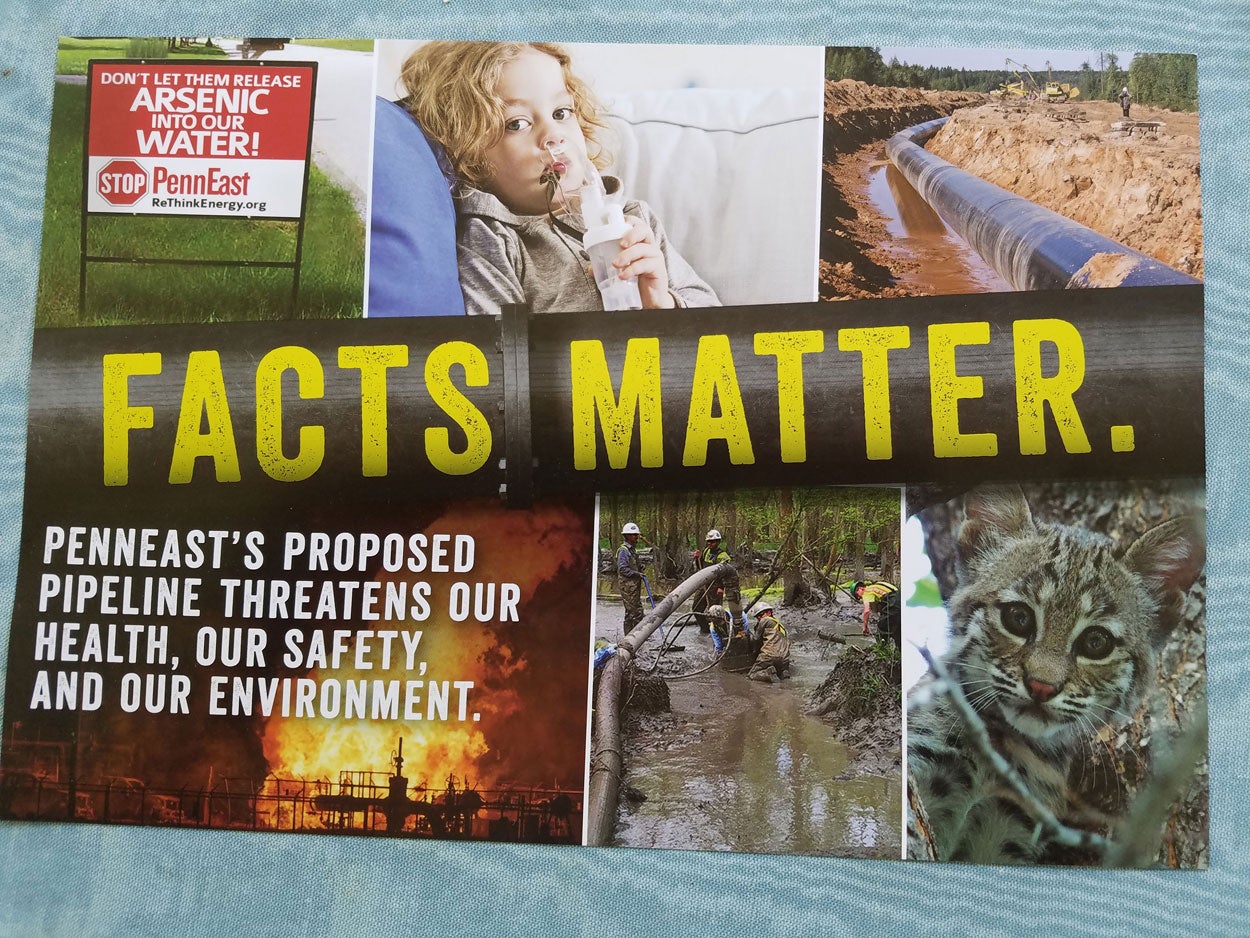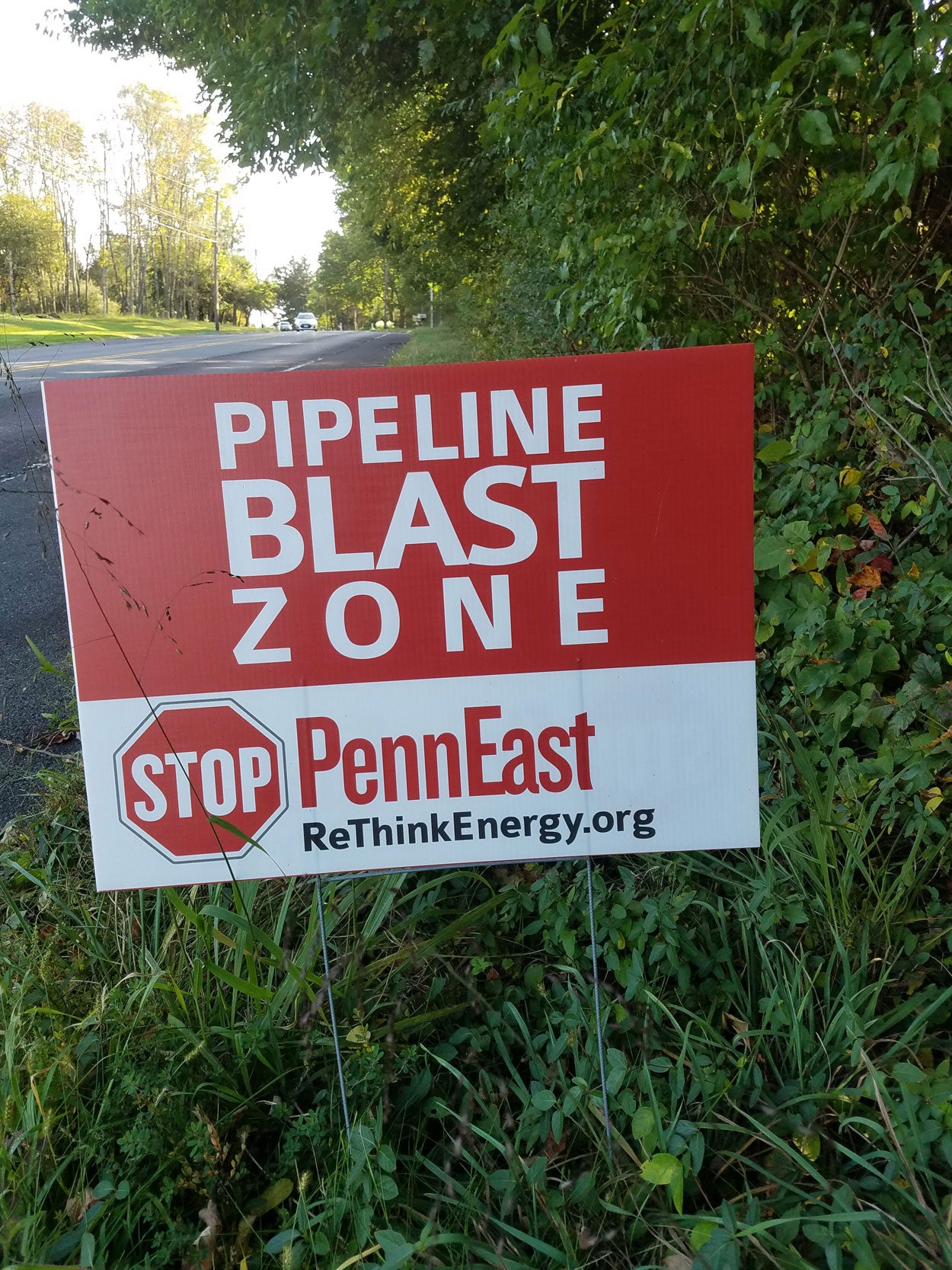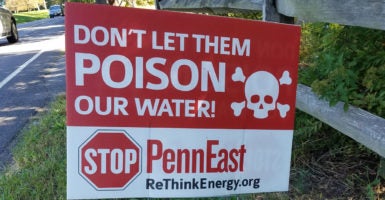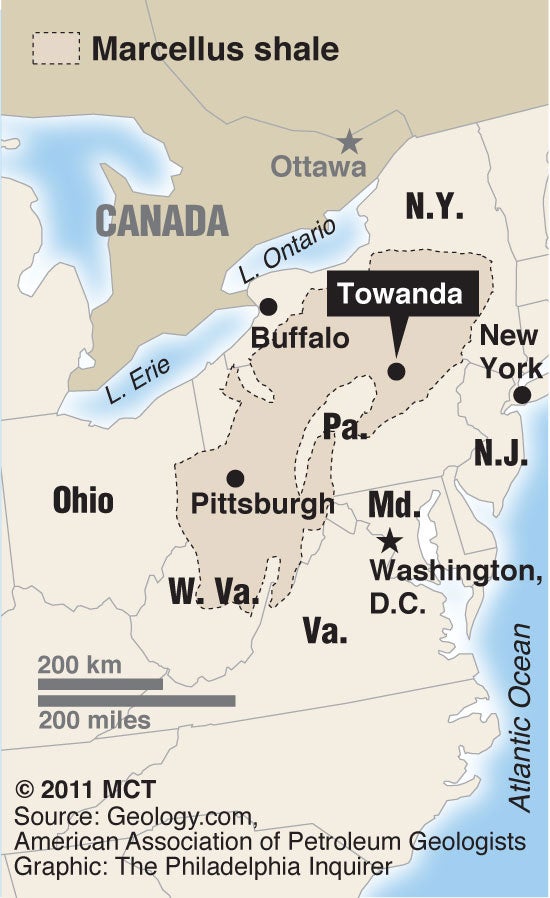Anyone traveling along the roadways that run parallel to that part of the Delaware River where George Washington staged his famous Christmas night crossing in 1776 is sure to encounter signs that take aim at an energy project known as the PennEast Pipeline.
Some of those signs invoke revolutionary language with statements that claim “We the People Say No to PennEast.”
Other signs say: “Don’t Let them Poison Our Water! Stop PennEast,” “Pipeline Blast Zone, Stop PennEast,” “Just Say No! Stop PennEast,” and “Stop the Fracking Pipelines.”
The messages opposing the natural gas pipeline can be spotted along roadways on both the Pennsylvania and New Jersey sides of the river.
Any day now, the six energy companies that are part of the PennEast Pipeline project expect to get a green light to proceed from the Federal Energy Regulatory Commission, which regulates the interstate transmission of natural gas, oil, and electricity. That approval would come in the form of a certificate allowing construction and operation of the pipeline.
The anti-pipeline signs and mailings mention ReThink Energy NJ, a coalition of environmentalists who have received substantial funding from the Philadelphia-based William Penn Foundation.
Under current plans, the proposed 120-mile-long, 36-inch-diameter, underground pipeline would originate just north of Wilkes-Barre, Pennsylvania, in an area that interconnects with other major interstate pipelines that serve markets on the East Coast, including New York, New Jersey, and Pennsylvania.
Wilkes-Barre, the county seat of Luzerne County, sits on the outskirts of the Pocono Mountains in the northeastern part of Pennsylvania.
If the federal commission OKs it, a year from now a new pipeline will be poised to transport natural gas across Eastern Pennsylvania and the Delaware River into Mercer County, New Jersey, where it will interconnect with the Transco Pipeline in the borough of Pennington.
The PennEast Pipeline would draw from natural gas produced in the Marcellus shale formation that cuts across Pennsylvania, New York, and parts of Ohio and West Virginia.
‘The Least Cost Available’
Tony Cox, project manager for PennEast, told The Daily Signal in an interview that he expects energy consumers in Pennsylvania and New Jersey to begin to see the benefits of the pipeline beginning in the winter of 2018-2019.
With approval from the Federal Energy Regulatory Commission expected this fall, the seven-month construction phase would begin next spring, and the pipeline would become operational in the second half of next year, according to PennEast’s projected timeline.
“September is what we call a ‘shoulder month’ in the gas industry, because you are past the summer months, but you are not yet in the winter. This means you are in a period of low energy consumption,” Cox said, adding:
But we still see a vast disparity between the price of gas in the Marcellus region and in New Jersey. These price differences around the country are one of the drivers for natural gas infrastructure, and one of the obligations that gas utilities have is to procure the least cost of gas available.
Right now, as it relates to New Jersey, that gas is located 100 miles away in Pennsylvania. But as we can see from the price difference, there is not ample infrastructure to get the gas to where it needs to go.
As of late September, Cox noted, the price for natural gas delivery in the Marcellus Shale region was $1.79 per dekatherm (a unit of energy measurement), compared with $3.16 per dekatherm in New Jersey, according to Gas Daily, a publication that provides the oil and gas industry with analytical reports on prices in the energy markets. That’s a difference of $1.37, or 76.5 percent higher, in New Jersey.
“Right now, there’s not enough capacity to meet the energy demands of New Jersey residents during peak periods, as evidenced by the large price differentials between these two areas,” Cox said. “With PennEast, we will have the ability to dampen the impact of high-demand periods and provide cost savings.”
When the $1.37 price difference for natural gas between the Marcellus area of Pennsylvania and New Jersey is “amplified by the capacity PennEast will have to transport natural gas,” Cox said, he anticipates “more than a half of a billion dollars in savings” to New Jersey consumers.
Sierra Club Disputes Figures
The PennEast project manager is not alone in projecting substantial savings.
PennEast proponents point to a study from Concentric Energy Advisors—which describes itself as an independent management consulting and financial advisory firm focused on the North American energy industry—that found PennEast would provide savings of more than $500 million for electricity and natural gas consumers in Pennsylvania and savings of more than $400 million for consumers in New Jersey.
Despite the intense opposition of environmental activists, who view the pipeline as a danger to the region, PennEast appears set to secure the necessary regulatory approval to move forward.
In April, the Federal Energy Regulatory Commission issued a favorable final environmental impact statement for PennEast that said any potential impact would be “adequately minimized” through mitigation efforts.
In August, the U.S. Senate confirmed the Trump administration’s nominees to the commission, providing the agency with the quorum needed to approve projects such as PennEast.
But Jeff Tittel, director of the New Jersey Sierra Club, disputes the figures PennEast has circulated that show energy consumers stand to benefit financially from the new infrastructure. Instead, he anticipates the pipeline actually would raise costs.
“Individually, these companies [that are part of PennEast] have been seeking rate hikes to pay for the pipelines, because they cost money,” Tittel said. “They have to pay back investors. How does this save people money?”
Tittel also cited a report from Stephanie Brand, director of the New Jersey Division of Rate Counsel, who has expressed reservations about the pipeline’s cost and utility. The division’s mission is to advocate for energy consumers.
“PennEast is dangerous and unnecessary, and the PennEast companies are just trying to make money for themselves. This has nothing to do with consumers and their energy needs,” the Sierra Club leader said. “Natural gas is a commodity, and the price is set by commodity markets, and it’s just not true to say that the pipeline will lower prices.”
“The other problem is that the pipeline will pass through environmentally sensitive and scenic areas, and pass through quaint, bucolic little towns that depend on ecotourism. This is also a historic area, where [George] Washington crossed the Delaware.
“Now you’re going to have this big, ugly pipeline cutting through, and it’s going to hurt the economy,” Tittel said.

The front of an anti-pipeline flier mailed to New Jersey residents by ReThink Energy, a coalition funded by the William Penn Foundation. (Photo: Kevin Mooney/The Daily Signal)
‘Alternatives Are More Expensive’
In the “Frequently Asked Questions” section of its website, PennEast provides readers with detailed answers to questions about the project’s size and scope, potential economic benefits to consumers, environmental safeguards, and restoration efforts that will take place once the pipeline is completed. A separate report from PennEast describes how natural gas development will bring both economic and environmental benefits.
Pat Kornick, a spokeswoman for PennEast, said “well-funded” anti-pipeline activists who have maintained a constant presence in the public eye and in the media are not looking out for the best interests of the people they claim to represent.
“When people question the need for a new pipeline, they are not seeing the big price discrepancies that exist between the New Jersey marketplace and the Pennsylvania portions of the Marcellus, where natural gas is produced,” she said. “Pipelines are the cheapest, most effective way to bring natural gas to market. The alternatives to pipelines, which involve the trucking and transportation of liquefied natural gas, are much more expensive.”
The funding that stands behind the environmental activism directed against natural gas development is evident from the signs littering the roadways in New Jersey, and from mailings delivered to area residents.
Every member of the coalition called ReThink Energy, cited on the opposition materials, has received substantial funding from the William Penn Foundation, a private, nonprofit charity.
Grants the foundation distributed to ReThink Energy members in recent years include $395,000 in 2017 and $582,000 in 2015 to the New Jersey Conservation Foundation, $82,500 in 2016 to the Stony Brook-Millstone Watershed Association, and $227,400 in 2016 to the Pinelands Preservation Alliance.
Tom Shepstone, who operates the Natural Gas Now blog, a product of his research firm based in Honesdale, Pennsylvania, told The Daily Signal that the William Penn Foundation is not permitted to do any lobbying as a private charity. But, he argued, the organization is making an end run around the prohibition by distributing grants to environmental activists and compliant media outlets that do its bidding.
“As a private foundation, they shouldn’t be doing any lobbying, but when you think about it that’s all they do at the foundation,” Shepstone said. “When they pass out money year after year to certain groups, they are doing this to influence public policy.”
Foundation-Funded News Outlets Defend Coverage
Shepstone said he also sees a connection between the William Penn Foundation and negative press coverage of PennEast.
Philadelphia-based WHYY Inc., which has TV, radio, and digital news operations, has received $660,000 from William Penn for its StateImpact Pennsylvania news service. Community Foundation of New Jersey, which supports the NJ Spotlight news service, has received $350,200 from William Penn.
“So much of the narrative against PennEast is written by the people who are on the same side as the people spinning the narrative,” Shepstone said. “The groups opposed to the pipeline have a shared funding source in the form of the William Penn Foundation, and you also have StateImpact Pennsylvania and NJ Spotlight, which are funded by the William Penn Foundation.
“So, when an environmental group has something negative to say about PennEast, that’s immediately picked up by these two news services to echo it and repeat it. It is so sad to see newspaper reporters not pick up on these blatant conflicts of interest,” he said.
Lee Keough, editor-in-chief of NJ Spotlight, defended his organization’s coverage in an email Wednesday to The Daily Signal.
“We receive financial support from all sides of this issue—utilities, environmental groups, the William Penn Foundation, as well as PennEast itself,” Keough wrote, adding:
Take a look at our site today … You may have to reload a few times to see all the ads. Nor do I think we have necessarily taken a critical view of the issue, although we have given it a lot of coverage. That reflects the passion that pipelines engender locally.
WHYY, the media company behind the StateImpact Pennsylvania news service, also responded to The Daily Signal’s request for comment.
“We strive to present balanced and factual information that takes into account all sides of the pipeline issue,” Sandra Clark, WHYY vice president for news and civic dialogue, said in an email.
“As with all of our reporting, no funder dictates our editorial coverage in any way and, as always, we’re sensitive to potential or perceived conflicts of interest. The issues raised about our coverage of the PennEast Pipeline have no basis in fact.”
Foundation Mum on Funding
The Daily Signal repeatedly invited the William Penn Foundation to comment for this article on its funding of environmental groups and media organizations, and asked what its position is on PennEast. The foundation did not respond.
The Sierra Club Foundation received $300,000 from the William Penn Foundation in 2017 and $250,000 in 2016. But Tittel said his New Jersey chapter of the Sierra Club and the Sierra Club Foundation are two separate organizations, and his New Jersey group has not received funding from the foundation.
Tom Gilbert, campaign director for energy, climate, and natural resources at the New Jersey Conservation Foundation, declined to address his organization’s relationship with the William Penn Foundation, but explained why his group is opposed to the pipeline.
“We oppose PennEast because it would have significant impacts on thousands of acres of taxpayer preserved open space and farmland, some of the cleanest streams in the state, and habitat for threatened and endangered species,” Gilbert said in an email to The Daily Signal, adding:
Furthermore, energy experts and the N.J. Division of Rate Counsel have concluded that there is no evidence of need for the project, and it would be ‘unfair to ratepayers.’
PennEast faces tremendous opposition in New Jersey. Approximately two-thirds of the affected homeowners have refused to grant them survey access or easements. Every town in the path of the pipeline opposes it. Thousands of citizens spoke out against it during the FERC [Federal Energy Regulatory Commission] process.

One of the signs opposing the PennEast Pipeline that dot a road in Hopewell Township, New Jersey. (Photo: Kevin Mooney/The Daily Signal)
Real or Illusory Opposition?
The idea that there is a groundswell of opposition to the pipeline on the part of the public is highly suspect, Shepstone of the Natural Gas Now blog told The Daily Signal.
“When you see all these signs out there, you have to remember that the funding behind them comes from narrow special interests that do not speak for average citizens and from one rich family at the William Penn Foundation opposed to development,” he said.
“The public stands to benefit from the pipeline and from clean, affordable natural gas. These environmental groups are just shills for the William Penn Foundation, and with their echo chamber in the media, it makes the opposition seem bigger than it really is.”
Another key player is the Delaware Riverkeeper Network, a nonprofit based in Bristol, Pennsylvania, which has been a persistent opponent of PennEast since the project was first announced.
The Riverkeeper Network has been sharply critical of the Federal Energy Regulatory Commission and the agency’s positive environmental assessment of PennEast.
“There are very serious ramifications from PennEast for people’s health and safety,” Riverkeeper Network President Maya K. van Rossum said. “We are talking about devastation to very important habitats, wetlands, and forests, and increased pollution running off into our waterways, and this runoff contributing to erosion and the loss of habitat.”
The group released its own report on what it calls the economic costs of PennEast.
“The damage done by PennEast will far outpace any benefits,” van Rossum said. “The tradeoff is not worth it in terms of lives and livelihoods.”
The William Penn Foundation donated about $1.4 million to the Delaware Riverkeeper Network in 2017 and $914,000 in 2015. But van Rossum dismissed the idea that her organization takes direction from the foundation.
“That’s a false argument, a misrepresentation, and a red herring,” she said, adding:
We have multiple funding streams, and foundation funding is but one of them. When you apply for a foundation grant, you propose the work that you are going to do in the public interest, and the funder chooses whether or not to support that work. The funder does not give you money and then dictate what you are to do with it.
‘Held Hostage’
Jordan McGillis is a policy analyst with the Washington-based Institute for Energy Research, a nonprofit that supports a free-market approach to energy policy. McGillis is highly critical of the role the Delaware Riverkeeper Network has played through the PennEast approval process.
“Despite their proximity to the Marcellus Shale, New Jersey and the rest of the northeastern states pay some of the highest electricity rates in the country,” McGillis said. “The reason is that they’re being held hostage by the ‘keep-it-in-the-ground’ movement. In the case of New Jersey, one of the main culprits is the Delaware Riverkeeper Network and its frivolous lawsuits.”
The energy policy analyst added:
The pernicious effect groups like this have isn’t trivial. Each pipeline delay results in New Jersey residents paying millions of dollars more than is necessary for energy. A study by Concentric Energy Advisors estimated that people in New Jersey and eastern Pennsylvania could have saved $900 million in the winter of 2013-2014 had something like the Penneast pipeline been operable.
When you look at the 990s [IRS tax forms], and you see that groups like the Delaware Riverkeeper aren’t the local, grass-roots movements they purport to be, but rather are funded by megadonors like the William Penn Foundation, it adds to the frustration you feel for the people who bear the costs of the seemingly endless legal delays.
Shepstone, the Natural Gas Now blogger, told The Daily Signal that the Delaware River Basin Commission’s authority over pipelines “is highly questionable,” and he expects PennEast to go forward.
PennEast is working to obtain approval from the New Jersey Department of Environmental Protection and the Delaware River Basin Commission, a federal interstate agency.
But the ultimate authority rests with the Federal Energy Regulatory Commission. Earlier this year, the New Jersey environmental agency returned PennEast’s application, saying it wanted more information.
“We are still working with all of these local agencies to obtain their approval,” Kornick, the PennEast spokeswoman, said. “With the New Jersey Department of Environmental Protection, they didn’t reject our application. They said it was incomplete and asked for more information, which we are providing.”





























